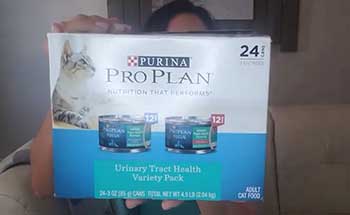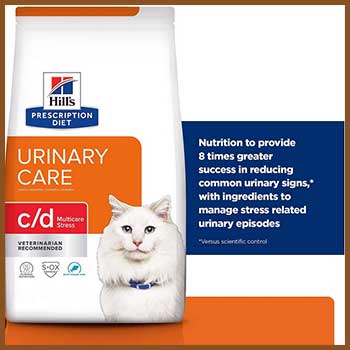Urinary tract issues are unfortunately common in cats. Studies show that 1 in 10 cats will develop a urinary tract problem at some point in their lives. As a cat owner, you want to do everything you can to keep your feline friend healthy. Diet plays a major role in supporting urinary tract health.
But with so many options out there, it can be confusing to know whether you need a prescription urinary food or if something like Purina Pro Plan Urinary Tract cat food will do the trick.
This comprehensive guide will walk you through the key differences between over-the-counter and prescription urinary cat foods, pros and cons of each, and what to consider when choosing the best food for your cat’s needs.
A Brief Comparison Table
| Feature | Purina Pro Plan | Prescription Urinary Food |
| Cost | Less expensive | More expensive |
| Availability | At stores and online | Through veterinarians only |
| Nutrition | Reduced minerals, increased fluids | Customized mineral levels, alkalizing effects |
| Purpose | General urinary care | Targeted for cat’s specific issue |
| Vet Involvement | Recommended | Prescribed and monitored |
| Flavors | Wide flavor variety | Limited flavors |
| Results | Improves urinary environment | Rapid symptom relief |
Overview Of Feline Lower Urinary Tract Disease
Before diving into diet specifics, it’s helpful to understand why urinary issues develop in cats. Feline Lower Urinary Tract Disease (FLUTD) is a broad term for disorders affecting a cat’s bladder and urethra. Some common causes include:
- Bladder stones – Mineral deposits that form crystals in the urinary tract. Struvite and calcium oxalate stones are most common.
- Bladder inflammation – Also called cystitis, inflammation makes it painful for a cat to urinate.
- Urethral blockages – Crystals, mucus, or stones block the urethra so a cat can’t urinate. This is a life-threatening emergency.
- Bacterial infections – Cats can get UTIs just like humans do.
- Idiopathic cystitis – This is when inflammation occurs for an unknown reason.
FLUTD signs include frequent urination, straining, blood in urine, crying in the litter box, excessive licking of genitals, and urinating outside the box. So feeding a urinary care diet is crucial for both treating current problems and preventing recurrence.
Now let’s explore how Purina diets compare to prescription options.
Purina Pro Plan Urinary Tract Health
Purina Pro Plan makes a few different over-the-counter formulas marketed for urinary health.

Key features include:
- Reduced magnesium – Lower magnesium levels help prevent struvite crystal formation.
- Increased EPA and DHA – These omega-3 fatty acids help reduce inflammation.
- Added antioxidants – Antioxidants like vitamin E promote a healthy urinary tract environment.
- Increased fluids – Some Pro Plan urinary foods have extra water content to encourage more frequent urination. This helps flush the system.
So while not as tailored as prescription food, Pro Plan does take steps to address common causes of FLUTD. There are both dry and wet options to suit your cat’s preferences.
Pros:
- Easily available at pet stores and online
- Less expensive than prescription brands
- Veterinarian recommended brand
- Palatable flavors cats enjoy
Cons:
- Not customized to your cat’s needs
- May not dissolve struvite stones or prevent recurrence as well as prescription food
Also Read: Differences Between Omega Paw Elite And Premium.
Prescription Urinary Cat Food
Prescription diets are only available with a vet’s approval. They are designed to address specific urinary issues and needs.

Here’s how they differ from OTC foods:
- Prescribed for a purpose – Your vet will recommend a food tailored for your cat, whether it be dissolving stones, fighting infection, or managing idiopathic cystitis.
- Lower mineral content – Restricted levels of minerals like magnesium, phosphorus, calcium and oxalate help dissolve stones and crystals.
- Alkalinizing effects – Makes urine less acidic, which improves the environment.
- Increased hydration – Higher moisture foods promote frequent urination.
Examples of prescription foods are Royal Canin Urinary SO, Hills c/d Multicare, and Purina NF Kidney Function.
Pros:
- Customized nutrition for your cat’s needs
- Best dissolve struvite stones
- Addresses inflammation and infections
- Vet monitored while transitioning food
Cons:
- More expensive
- Only available through veterinarian
- Some cats resist the flavor
So prescription diets offer very tailored nutrition, but may not be necessary for every cat suffering from mild FLUTD issues.
Key Considerations For Choosing Food
When deciding between Purina Pro Plan and prescription options, keep these tips in mind:
- Follow your vet’s advice – They’ll make food recommendations based on your cat’s case, medical history, and test results. Get their input before switching foods.
- Transition slowly – Gradually transition to a new food over 5-7 days. This prevents GI upset.
- Try wet food – The extra moisture helps reduce crystal formation and makes urination easier if there’s inflammation.
- Stick with it – It can take weeks on a special diet to fully dissolve bladder stones and get inflammation under control.
- Prevent triggers – Things like stress, inactivity, and dehydration can provoke FLUTD. Help your cat avoid these.
- Weigh cost – Prescription diets are more expensive. But they also might resolve symptoms faster.
No two cats are alike. Work closely with your vet to choose the right urinary care diet. Lifestyle factors are also key for promoting urinary tract health long-term.
Also Read: Is Zesty Paws Salmon Bites Better Than Omega Bites?
Frequently Asked Questions (FAQ)
The main difference is prescription foods are customized to address a cat’s specific urinary issues, like struvite crystals or UTIs. They restrict minerals and manipulate pH levels in ways general foods don’t. Prescriptions are also monitored by a vet.
You may not need it for mild issues. But prescription food is recommended for recurrent UTIs, frequent FLUTD flare-ups, or when stones have formed. Check with your vet. The goal is to manage symptoms and prevent escalation to dangerous blockages.
Most cats can eat prescription food safely. It’s designed to support their urinary system. Check label guidelines for exceptions. Kittens and pregnant or nursing cats may have different nutritional needs. Again, consult your vet before making a switch.
Purina Pro Plan Urinary Tract Health formulas can be a good option for cats prone to FLUTD issues. While not prescription strength, Pro Plan does restrict minerals and incorporate nutrients to support urinary health. Many vets recommend it. But your vet may advise prescription food for more severe cases.
Also Read: Comparison Betweeen Angel Eyes Plus And Natural Tear Stains Treatments For Dogs.
Conclusion
Diet plays an important role in minimizing urinary problems for cats. Purina Pro Plan Veterinary Diets offer a non-prescription option with nutritional benefits. But prescription foods tailored by a vet should be considered for recurrent issues or bladder stones. Work with your veterinarian to choose the best food for your cat’s needs and keeping their urinary tract healthy.
